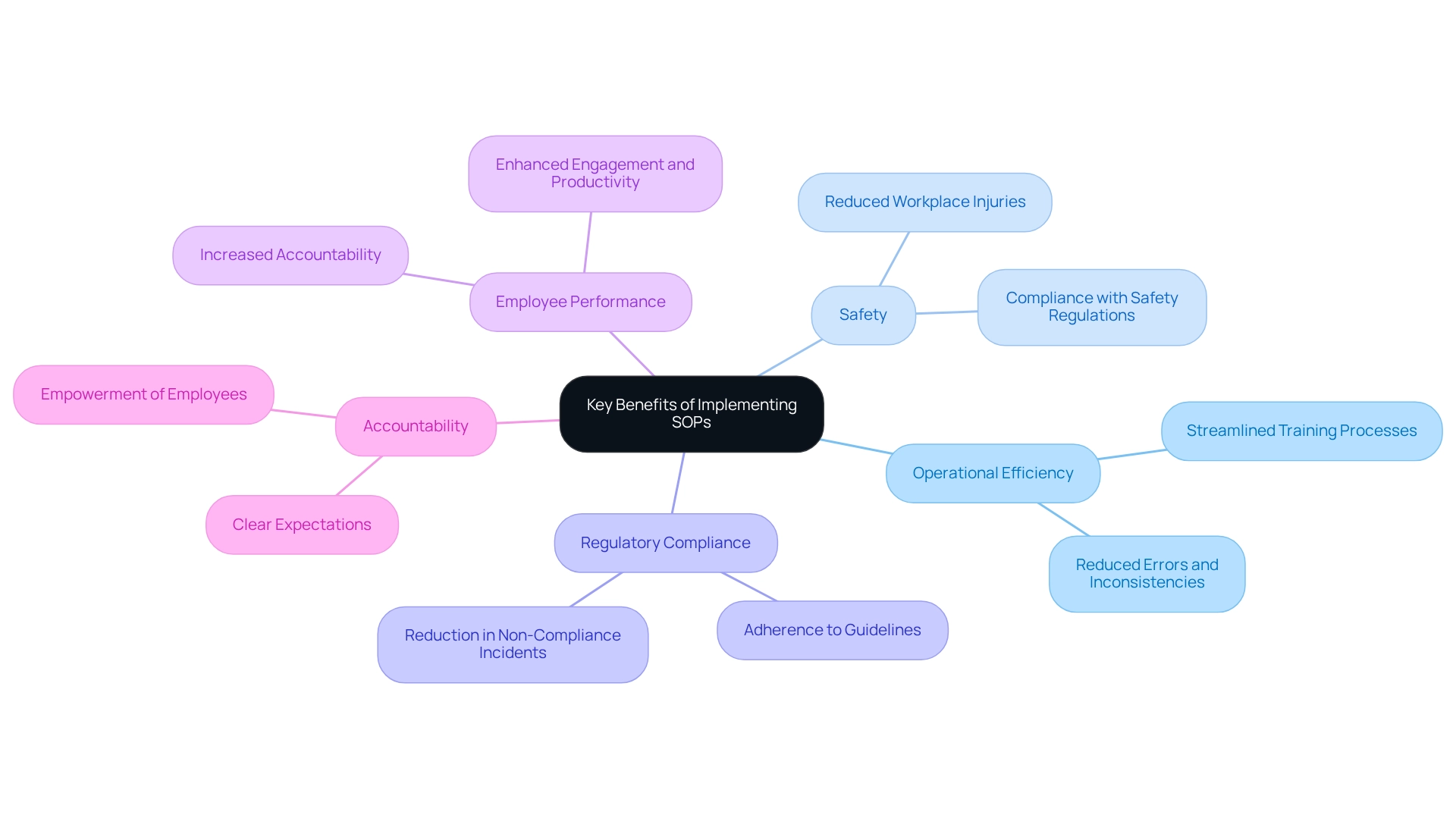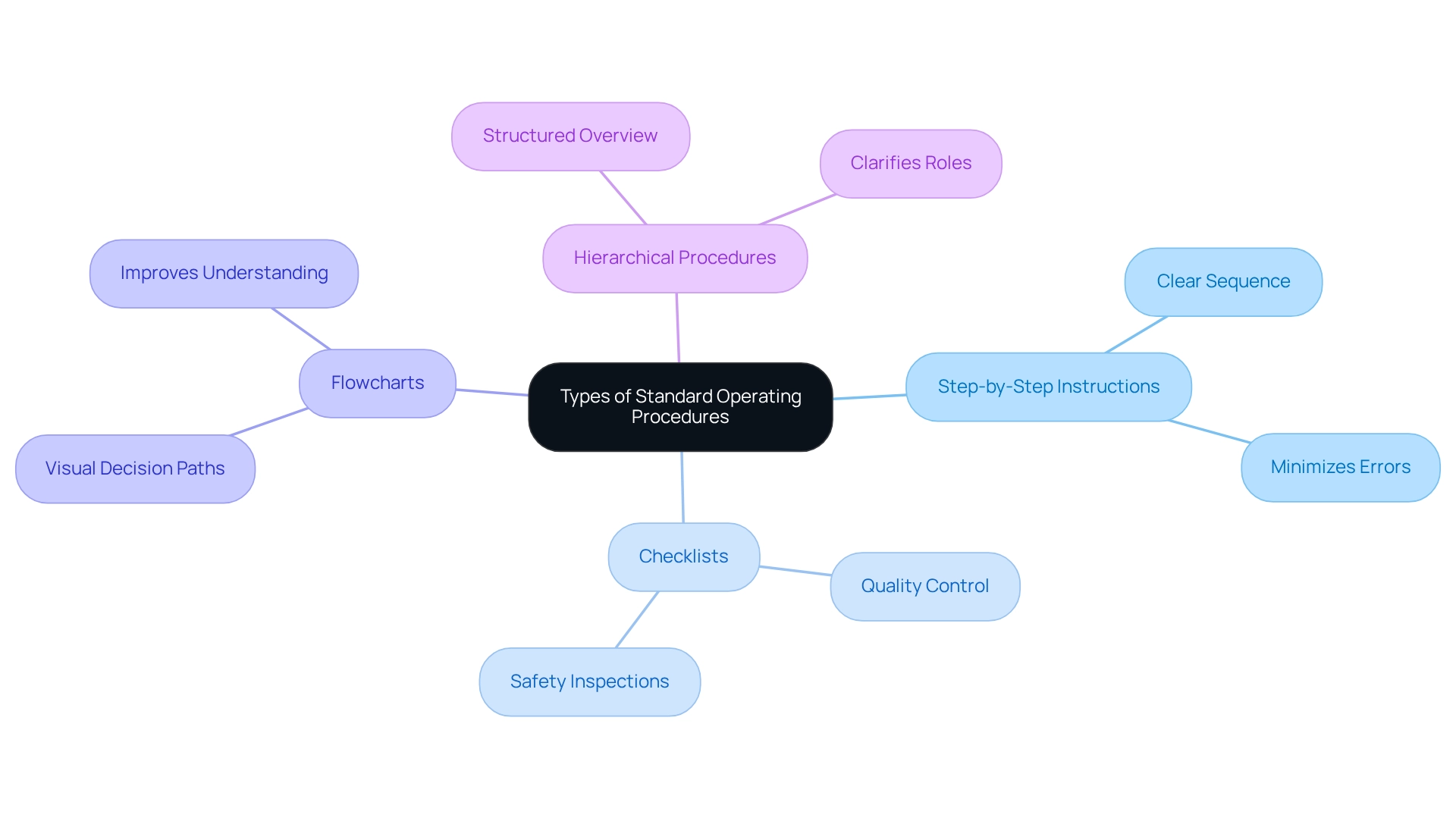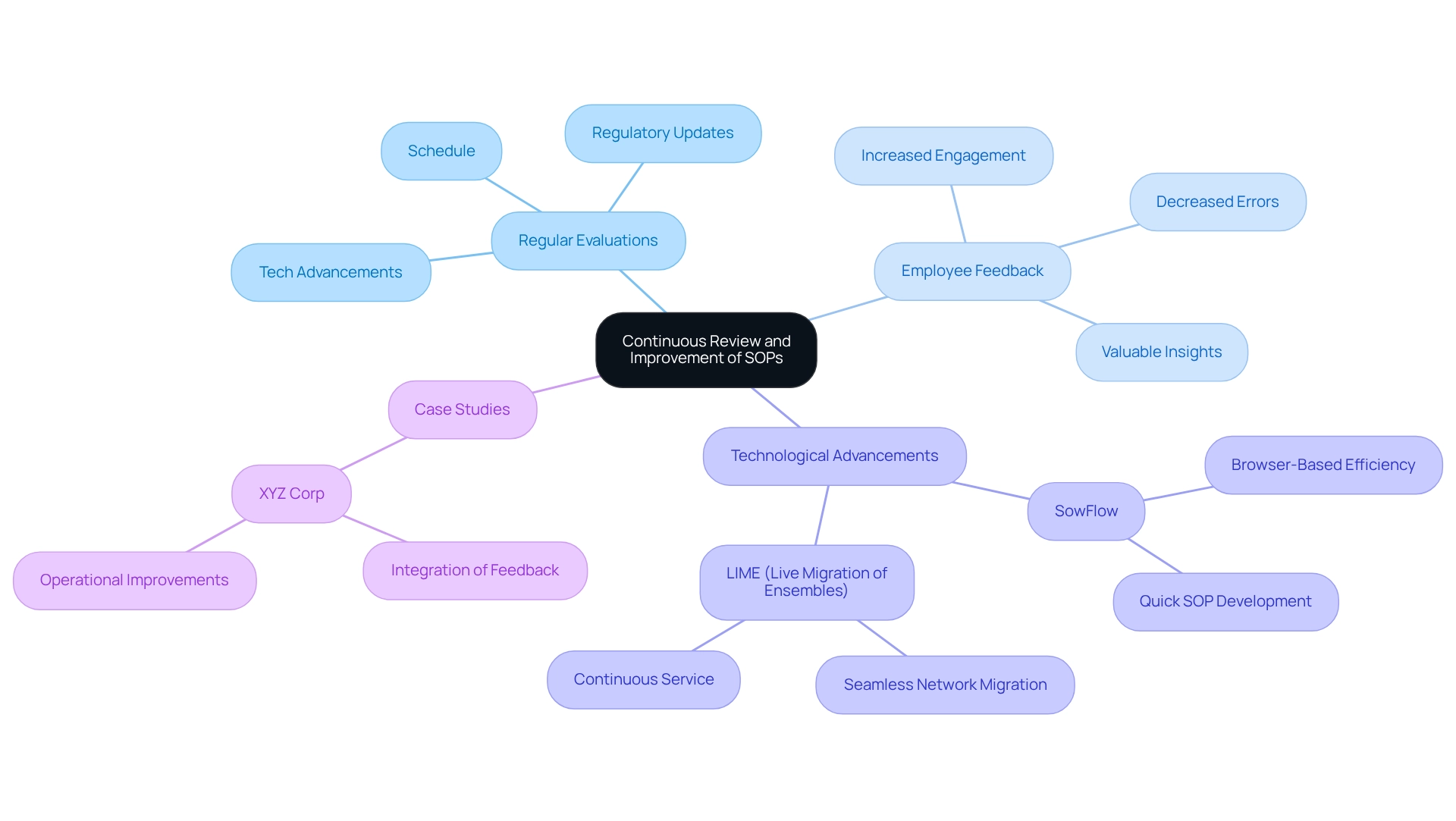
Process Improvement through Documentation
|
October 16, 2025
|
What Is Operating Procedures Definition? A Comprehensive Overview
Overview
You might be wondering what operating procedures are all about, especially when we talk about Standard Operating Procedures, or SOPs for short. Well, these are basically documented guidelines that lay out the specific steps needed to tackle routine tasks in an organization. The goal? To standardize processes and boost operational efficiency! Now, isn’t that something we all could use?
Effective SOPs do more than just provide a checklist. They actually help improve employee performance, cut down on variability, and make training a breeze. When everyone’s on the same page, it leads to increased productivity and compliance, no matter what type of business environment you're in. So, how can you start implementing these helpful tools in your workplace? Let’s dive into that!
Key Highlights:
- Standard Operating Procedures (SOPs) standardize processes, reduce variability, and enhance operational efficiency.
- Employees spend over 100 minutes daily searching for information, highlighting the need for clear SOPs.
- Effective SOPs improve employee performance and accountability, as shown in the BPKD Aceh Barat study.
- Clarity, accessibility, and adaptability are crucial for SOP effectiveness in a fast-paced business environment.
- SOPs play a vital role in training new employees, reducing the learning curve and boosting productivity.
- Common formats for SOPs include step-by-step instructions, checklists, flowcharts, and hierarchical procedures.
- Regularly reviewing and updating SOPs is essential for maintaining relevance and compliance with regulations.
- Challenges in SOP development include resistance to change, lack of clarity, inadequate training, and keeping procedures updated.
- Engaging employees in the SOP development process can foster ownership and minimize resistance.
- Continuous review and improvement of SOPs can lead to increased operational efficiency and employee engagement.
Introduction
In the intricate landscape of modern business operations, you might be wondering how Standard Operating Procedures (SOPs) fit in. Well, they’re critical tools that streamline processes and boost efficiency! Think of these formalized documents as the backbone of organizational consistency, allowing teams to tackle tasks with precision and clarity. As companies navigate the challenges of maintaining quality and compliance in today’s ever-evolving environment, the importance of well-structured SOPs really stands out.
From enhancing employee performance to nurturing a culture of continuous improvement, the benefits of implementing SOPs are both vast and transformative. Now, let’s dive into the essential elements of SOPs, explore their impact on business operations, and discuss some strategies organizations can adopt to create and maintain effective documentation that drives success. You’ll see just how powerful these tools can be!
Understanding Standard Operating Procedures (SOPs)
You might be wondering what the operating procedures definition really means. Well, it refers to those essential documents that lay out the specific steps needed to tackle routine tasks in an organization. Their main goal? To standardize processes based on this definition, which helps minimize variability and boost operational efficiency. By offering clear, step-by-step instructions, the operating procedures definition empowers employees to perform their roles consistently. This consistency is key for maintaining quality standards and ensuring compliance with industry regulations.
Now, let’s talk numbers. Did you know that employees spend over 100 minutes each workday just searching for information? That’s more than 20% of their time! This inefficiency really highlights why the operating procedures definition is so important. It not only streamlines access to information but also speeds up decision-making and action. Organizations that embrace this definition can see operational efficiency soar by up to 30%, which significantly enhances customer satisfaction and builds brand loyalty. So, what makes an effective operating procedures definition? It’s all about clarity, accessibility, and adaptability.
These documents should be written in clear language, easily accessible to everyone, and regularly updated to reflect any changes in procedures or regulations. This adaptability is especially crucial in today’s fast-paced business world, where being agile in hiring and training is a must. The definition of provides clear, repeatable steps that reduce friction within the organization, enabling teams to respond swiftly when needed.
Let’s look at some practical examples. In industries where adherence to protocols and safety is paramount, the operating procedures definition plays a vital role in minimizing deviations from established guidelines, thus preserving operational integrity. Take the case study involving BPKD Aceh Barat, for instance. It showed that applying standard operating procedures had a significant positive impact on employee performance, proving their worth in boosting productivity and consistency.
The findings were clear: the operating procedures definition greatly enhanced employee performance, highlighting how crucial these protocols are for achieving success in any business.
Looking ahead to 2025, a significant number of companies are expected to adopt standard operating procedures for process uniformity. This trend shows a growing recognition of their value in enhancing operational reliability. Industry leaders emphasize that the definition of standard operating procedures isn’t just a bureaucratic necessity; it’s essential for maintaining operational integrity and ensuring that every team member knows their role. This clarity is vital for quick and effective responses when challenges arise. In summary, if companies want to improve efficiency, maintain quality, and foster a culture of continuous improvement, the definition of standard operating procedures is absolutely essential.
The Importance of SOPs in Business Operations
You might be wondering why (SOPs) are such a big deal for businesses. Well, they’re essential for effective operations, providing a structured framework that helps everyone execute tasks consistently across the board. This consistency is super important, especially in industries like manufacturing, healthcare, and food service, where sticking to quality standards and regulatory requirements is crucial.
Not only do SOPs streamline processes, but they also play a vital role in training and onboarding new employees. By offering clear, step-by-step instructions, SOPs help newcomers quickly grasp their roles and responsibilities. This means a shorter learning curve and smoother integration into the team, which minimizes errors and boosts productivity.
Recent studies really underscore how standardized procedures can enhance employee performance. For example, a study titled 'Impact of Standard Operating Procedures on Employee Performance at BPKD Aceh Barat' conducted at the West Aceh Regional Financial and Asset Management Agency (BPKD) found that these procedures significantly improve performance. With a t count of 5.015—well above the critical t table value of 2.00—it’s clear that SOPs make a difference. As Eti Yuliana Mahrizal pointed out, "The results showed that SOP had a positive and significant impact on the performance of BPKD Aceh Barat employees."
This finding really highlights the connection between having and better operational outcomes, based on a sample of 85 employees.
Now, as companies grow and change, SOPs provide a flexible foundation that can adapt to new products, services, or markets. This ensures quality and efficiency during growth phases. By standardizing procedures, organizations can enhance their operating procedures, leading to improved productivity and a more structured operational framework. Ultimately, this helps them achieve their business goals more effectively.
Speaking of efficiency, let’s talk about SowFlow. It’s been a game changer for teams when it comes to documenting work and delivering to clients. Anastasia Masadi, a Product Owner, shares, "I do not have to take each screenshot separately, and do not even have to leave the browser while I am creating standard operating procedures and training materials. SowFlow gave me time from my life back."
This really shows how SowFlow allows teams to develop SOPs and training resources on the fly, changing the game for documentation methods. With features like automation and seamless integration, it makes creating SOPs much more efficient than traditional methods. By cutting out the need for manual screenshotting and letting users work right in their browser, SowFlow not only saves time but also boosts the quality and consistency of documentation.
Key Benefits of Implementing SOPs
You might be wondering why implementing Standard Operating Procedures (SOPs) is such a big deal. Well, let me tell you, the benefits are pretty impressive! Not only do they boost operational efficiency and safety, but they also help organizations stay on top of regulatory compliance. By laying out clear and detailed guidelines, SOPs reduce the chances of errors and inconsistencies, leading to higher quality outputs. Research shows that organizations with solid procedures see noticeable improvements in employee performance and accountability. When staff members know exactly what’s expected of them, they can really shine in their roles.
As pointed out, "The results showed that SOP had a positive and significant impact on the performance of BPKD Aceh Barat employees." That’s a great example of how effective SOPs can make a real difference!
Now, let’s talk about training. The definition of standard operating procedures is super important for streamlining training processes. It cuts down on the time and resources needed to onboard new employees, which is a lifesaver in fast-paced environments where quick adaptation is key. When everyone knows their responsibilities, it creates a culture of involvement and empowerment among employees.
Speaking of making things easier, have you heard about SowFlow's instant documentation solution? It allows companies to create and update user guides effortlessly, keeping procedures relevant and accessible. With SowFlow, generating user guides and making quick updates is a breeze, which is essential for meeting the ever-changing needs of operations management. Beecher Lawton Hogan also noted that "the high degree of interest among respondents to have ready-made, adaptable standard operating procedures suggests that there is a role for extension agents to promote the positive benefits of standard operating procedures as well as creating adaptable templates for farmers."
And let’s not forget about safety! The advantages of having documented guidelines are huge; they ensure that employees follow safe practices, which helps reduce workplace injuries. This is especially crucial in industries where compliance with safety regulations is non-negotiable. For instance, many organizations that have adopted the operating procedures definition report significant drops in incidents related to non-compliance. This clearly shows the link between implementing SOPs and enhancing workplace safety.
Case studies really highlight how transformative standard operating procedures can be. Take the case study titled "4 Ways the Importance of Standard Operating Procedures Transform Your Business"—it illustrates that organizations that document their processes effectively see improved employee engagement and productivity. This often leads to a favorable return on investment (ROI). It’s interesting to note that both well-executed and poorly-executed SOPs can dramatically impact operational outcomes, which underscores the importance of developing effective methods.
In summary, the key advantages of introducing standard operating procedures include improved efficiency, enhanced safety, better compliance with regulations, and increased employee accountability. As organizations navigate the complexities of today’s business landscape, the role of SOPs in fostering a structured and productive workplace is more crucial than ever. And let’s not forget, leveraging SowFlow's solutions can streamline this process even further, giving teams instant access to the documentation they need for effective workflow management.
Users of SowFlow's solutions rave about how simple it is to develop and manage standard operating procedures, showing just how much this platform tackles the challenges faced by Operations Managers.

Types of Standard Operating Procedures: Formats and Examples
You might be wondering how to define operating procedures, right? Well, it’s all about categorizing Standard Operating Procedures (SOPs) into distinct formats that cater to specific operational needs. Let’s explore some of the most common types you might encounter:
- [Step-by-Step Instructions](https://sowflow.io/blog-post/create-a-step-by-step-list-for-effective-documentation-management): Think of these as your go-to guide for completing a task. They lay out a clear sequence of actions, making them perfect for straightforward processes. You’ll find that they walk you through each phase, ensuring everything’s crystal clear and minimizing the chances of errors.
- Checklists: If you’re involved in quality control or safety inspections, checklists are your best friends. They ensure that every necessary step is ticked off, serving as a quick reference to make sure nothing critical slips through the cracks. This boosts operational reliability, which is always a plus!
- Flowcharts: Now, if you like visuals, flowcharts are fantastic! They illustrate decision-making paths, making them essential for those complex procedures that can lead to various outcomes. As Haynes points out, a visual approach can really help avoid mistakes and improve understanding among team members.
- Hierarchical Procedures: These documents offer a structured overview of processes, outlining the relationships between different tasks and their responsibilities. This format is especially handy for organizations with intricate operations, as it clarifies roles and boosts accountability.
When it comes to picking the right format for your SOPs, consider the complexity of the tasks and your specific operational needs. For instance, frontline maintenance technicians often have practical insights that can help shape effective and user-friendly SOPs.
And here’s a tip: regularly reviewing and updating your operating procedures definition is key to keeping things relevant and effective. Did you know that organizations that systematically review their SOPs tend to see improved compliance and efficiency? Plus, in today’s remote work world, having SOPs accessible in a cloud-based format means employees can find them anywhere, which definitely enhances productivity.
Take a look at the case study titled '[Progressive Implementation of SOPs](https://manutan.com/blog/en/optimisation-levers/standard-operating-procedures-sops-challenges).' It shows that rolling out SOPs should be a gradual process, starting with a pilot department before a full organization-wide implementation. This way, transitions are smoother, and teams stay informed about any changes. By understanding the various SOP formats and their uses, you can create efficient documentation that promotes consistent methods and fosters a culture of continuous improvement.

Essential Components of an Effective SOP
An effective Standard Operating Procedure (SOP) needs a few key components to really shine and be user-friendly.
First up, the Title. You want to make sure it clearly states the name of the procedure so it’s easy to spot. Then there’s the Purpose. This is where you explain why the SOP is important and what it aims to achieve. It helps everyone grasp the operating procedures definition and its role in the bigger picture.
Next, let’s talk about the Scope. This part specifies who the SOP affects and under what conditions, which sets clear boundaries for its use. Now, don’t forget about Responsibilities. It’s crucial to outline who’s doing what in the operating procedures definition. This fosters accountability and ensures everyone knows their part.
The heart of the SOP is the Operating procedures definition itself. It’s a step-by-step guide that details the tasks to be performed, ensuring everything runs smoothly and consistently. Also, include References. Listing relevant documents, regulations, or standards supports the operating procedures definition and lays the groundwork for compliance and best practices. Finally, wrap it up with Approval Signatures. This shows that the relevant authorities have signed off on the operating procedures definition, adding a layer of accountability and formal recognition.
Now, here’s a fun fact: statistics show that organizations often juggle hundreds or even thousands of standard operating procedures! This really highlights how crucial clarity and usability are in documentation. Regular training and updates are key to keeping those SOPs relevant and effective, making sure everyone stays compliant and informed.
By using SowFlow's instant documentation solution, operations managers can simplify the creation and updating of SOPs, boosting team efficiency and knowledge sharing. SowFlow makes it easy for users to create user guides effortlessly, letting them tap into their documentation wisdom with just one command. This way, you can avoid those endless meetings where everyone’s scrambling for answers.
Take a look at the case study named 'Procedures Fix a Leaky Bucket.' It shows how companies that grow without solid documentation often face significant knowledge loss due to verbal and inconsistent knowledge transfer. By implementing standardized operating procedures with SowFlow, these companies can document essential processes, preventing knowledge loss from employee turnover and keeping valuable information intact.
As experts point out, sticking to the operating procedures definition is crucial for ensuring consistency, efficiency, safety, and quality in day-to-day operations. Plus, using digital technologies and following FAIR data principles can greatly enhance SOP management, making them clearer and more user-friendly in our fast-paced business world.

How to Write Standard Operating Procedures: A Step-by-Step Guide
Creating an effective Standard Operating Procedure (SOP) is a systematic task that requires some thoughtful planning and execution, all guided by the definition of operating procedures. So, how do you get started? Here are the essential steps to help you out:
- Identify the Procedure: First things first, pinpoint the specific procedure that needs documentation. Gather all the relevant info to ensure you have a solid understanding.
- Gather Input: Involving stakeholders and subject matter experts is super important. Their insights not only boost the accuracy of the SOP but also make sure it meets the needs of everyone involved. Plus, getting them in early fosters a sense of ownership, which can lead to more effective documentation.
- Choose a Format: Next up, select a suitable format for the SOP based on how complex the task is. A well-structured format helps with clarity and usability, making it easier for users to follow along.
- Draft the SOP: Now it’s time to write the SOP using clear and concise language. Stick to a structured approach that includes all essential components, ensuring that instructions are straightforward and easy to digest. With tools like SowFlow, you can whip up SOPs and training materials in no time, saving you from the hassle of taking separate screenshots or leaving your browser. As Anastasia Masadi, Product Owner, puts it, "SowFlow has been a game changer in the way we document work and deliver to our clients."
- Review and Revise: Once the draft is ready, share it with stakeholders for feedback. This collaborative evaluation is crucial for spotting any gaps or ambiguities, allowing you to make necessary tweaks before finalizing.
- Implement and Train: After you’ve finalized the SOP, distribute it to everyone who needs it. Don’t forget to provide training on how to use the SOP effectively; this is key to ensuring compliance and understanding.
- Monitor and Update: Finally, make it a habit to regularly review the SOP to keep it relevant and effective. Periodic updates are essential to reflect any changes in processes or regulations, ensuring that the SOP remains a valuable resource.
offers clear direction and instruction specifically designed to avoid deviations—an absolute must for maintaining compliance and delivering quality products. Including work instructions alongside standard operating procedures can also enhance clarity, especially when the procedures get a bit too detailed. This way, you can provide concise, step-by-step guidance tailored to different user groups, ensuring that all employees get the training and information they need.
Now, let’s talk about some common mistakes to steer clear of in documentation: overcomplicating instructions, ignoring the end-user's perspective, and neglecting updates. By sticking to these steps and best practices, you can develop standard operating procedures that not only meet regulations but also boost operational efficiency and quality management. And remember, SowFlow is here to help teams streamline this process, making documentation not just efficient but also a seamless part of daily operations, ultimately tackling those common pitfalls.
Challenges in SOP Development and Maintenance
Developing and maintaining Standard Operating Procedures (SOPs) can be quite the adventure, right? Organizations face several significant challenges that they need to navigate effectively.
You might be wondering about some of these hurdles. One common issue is resistance to change. Employees often hesitate to adopt new procedures, especially if they're used to doing things a certain way. This reluctance can come from a fear of the unknown or simply believing that the old methods are just fine.
Then there's the lack of clarity. If standard operating procedures are poorly written, confusion can set in, leading to misinterpretation and undermining their effectiveness. Clear and concise documentation is essential to ensure everyone knows what’s expected of them.
Another challenge is inadequate training. Without proper training, employees might struggle to understand and apply the SOPs correctly. That's why comprehensive training programs are crucial—they equip staff with the knowledge and skills they need.
And let’s not forget about keeping procedures updated! As business activities evolve, ensuring that SOPs remain relevant and accurate can be tough. Organizations should establish a systematic approach to regularly review and update their SOPs to reflect current practices.
So, how can companies tackle these challenges? Engaging employees in the development process can foster a sense of ownership and minimize resistance. Plus, providing thorough training ensures that everyone is well-prepared to implement the new procedures. Creating a consistent review timetable can also help keep everything up to date with changing business needs.
According to Plant Engineering’s Facilities Maintenance 2019 Report, 39 percent of organizations still rely on traditional recordkeeping systems, which can really hinder . This highlights the importance of investing in technology and fostering collaboration to enhance the SOPs and their maintenance. A review of 90 articles and guidelines supports the challenges discussed, emphasizing the need for continuous learning and adaptation in SOP management.
Case studies show that organizations that maintain a single version of each SOP, as highlighted in the case study titled 'Managing Versions of SOPs,' achieve greater consistency in their operations. This approach helps minimize the risk of employees following outdated or conflicting procedures, ultimately leading to better outcomes. By overcoming resistance to change and implementing best practices in SOP management, organizations can boost their operational efficiency and ensure that their processes align with the SOPs and strategic goals.
Additionally, organizations can implement strategies like improving data quality, enhancing communication, investing in technology, and fostering collaboration to tackle S&OP challenges. Now, let’s dive into how you can make these changes work for you!
The Need for Continuous Review and Improvement of SOPs
You might be wondering why the continuous review and improvement of operating procedures is so crucial. Well, it’s all about keeping things effective and relevant! Organizations really should set up a regular schedule for evaluations, considering any changes in procedures, updates in regulations, and the latest tech advancements. Research shows that companies that make regular updates to their operating procedures see a big boost in operational efficiency and compliance rates.
Now, let’s talk about employee feedback—it’s a game changer in this whole process. Those who use standard operating procedures every day can share valuable insights about practical challenges and areas that need some tweaking. By creating a culture of ongoing improvement, businesses not only keep their operating procedures aligned with their goals but also empower employees to contribute to the company's success.
Did you know that companies with solid feedback mechanisms for SOPs report a 30% increase in employee engagement and a 25% drop in compliance errors? Take XYZ Corp, for example. They’ve effectively woven employee feedback into , which has led to smoother operations and happier employees.
Speaking of updates, successful organizations typically refresh their SOPs every six months. This shows a real commitment to maintaining high standards. Eric Keller puts it well: "Experiments with our initial prototype suggest that network migration does not have to be a disruptive event, but can become an integral management mechanism completely transparent to applications." This highlights how tech advancements can really enhance the management of operating procedures, especially when it comes to boosting operational efficiency.
A fantastic illustration of this transformation comes from Anastasia Masadi, a Product Owner, who says, "SowFlow has been a game changer in the way we document work and deliver to our clients. I do not have to take each screenshot individually, and do not even need to exit the browser while I am producing standard operating procedures and training materials. SowFlow gave me time from my life back." Her experience shows how SowFlow helps teams quickly develop SOPs and training materials, making documentation tasks a breeze with its browser-based efficiency.
Looking at case studies, like the implementation of LIME (Live Migration of Ensembles), we see how continuous review processes can facilitate smooth operational transitions without any service hiccups. This underscores the importance of proactively managing the operating procedures definition. By adopting these practices, organizations can ensure their SOPs remain effective tools for achieving operational excellence. Plus, with a research database boasting over 2.3 billion citations, the significance of data in refining SOPs and operational practices is hard to ignore.
As we look to the future, Retail SOPs will undoubtedly evolve with these technological advancements and the push for digital integration, making continuous review and improvement absolutely essential.

Conclusion
You might be wondering why implementing Standard Operating Procedures (SOPs) is such a big deal. Well, it’s not just about ticking boxes; it’s a key strategy for boosting efficiency, safety, and compliance across different industries. SOPs lay out clear, structured guidelines that help employees perform tasks consistently and effectively. This not only cuts down on errors but also builds a culture of accountability. Research and case studies show just how transformative SOPs can be for employee performance, quality control, and overall success.
Now, let’s talk about why adaptability is so important in today’s fast-paced business world. As your organization grows and changes, your procedures need to keep up. Regularly reviewing and updating SOPs ensures they stay relevant and in line with current practices and regulations. Plus, when you involve employees in this process, you not only enhance the quality of the documentation but also create a sense of ownership and commitment to the procedures.
In short, continuously improving SOPs is vital for any organization striving for operational excellence. By using tools like SowFlow to streamline the creation and maintenance of SOPs, you can make sure your teams have what they need to work efficiently and effectively. As the business landscape evolves, leveraging SOPs will continue to be crucial for maintaining a competitive edge and nurturing a culture of ongoing improvement. Embracing these practices will lead to better performance, increased employee satisfaction, and ultimately, success in reaching your organizational goals.
Frequently Asked Questions
What is the definition of operating procedures?
Operating procedures refer to essential documents that outline specific steps needed to perform routine tasks in an organization, aiming to standardize processes to minimize variability and enhance operational efficiency.
Why are operating procedures important for organizations?
They help standardize processes, reduce variability, improve operational efficiency, maintain quality standards, and ensure compliance with industry regulations.
How much time do employees typically spend searching for information?
Employees spend over 100 minutes each workday searching for information, which accounts for more than 20% of their time.
What impact can effective operating procedures have on operational efficiency?
Organizations that implement effective operating procedures can see operational efficiency increase by up to 30%, leading to enhanced customer satisfaction and brand loyalty.
What characteristics make an effective operating procedures definition?
It should be clear, accessible to everyone, and regularly updated to reflect changes in procedures or regulations.
How do operating procedures contribute to employee performance?
They provide clear, repeatable steps that reduce friction within the organization, allowing teams to respond quickly and effectively, thus enhancing employee performance.
Can you provide an example of the impact of operating procedures?
A case study at BPKD Aceh Barat demonstrated that applying standard operating procedures significantly improved employee performance and productivity.
What is the future trend regarding standard operating procedures?
A significant number of companies are expected to adopt standard operating procedures for process uniformity by 2025, recognizing their value in enhancing operational reliability.
How do standard operating procedures aid in training and onboarding new employees?
SOPs offer clear, step-by-step instructions that help newcomers quickly understand their roles and responsibilities, leading to a shorter learning curve and smoother integration into the team.
What is SowFlow and how does it relate to standard operating procedures?
SowFlow is a tool that streamlines the documentation of work and the creation of SOPs and training materials, allowing teams to produce these resources efficiently without the need for manual processes like screenshotting.
👍
What others are liking
5 Steps to outline your ideal documentation structure
5 MINS READ
Where to start the your journey of mapping out your ideal documentation structure, aligning it with the very heartbeat of your organization?
Defining a winning level of detail in your process
3 MINS READ
What is too much detail, and what is too little? This article described in that winning level detail about what detail is enough.





